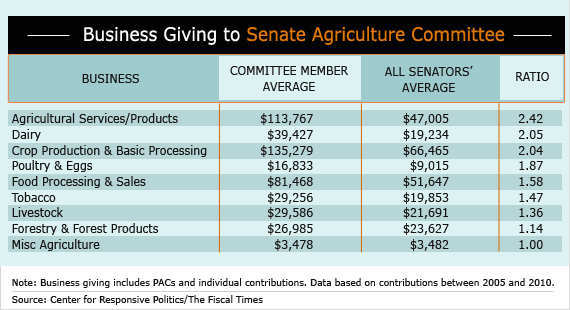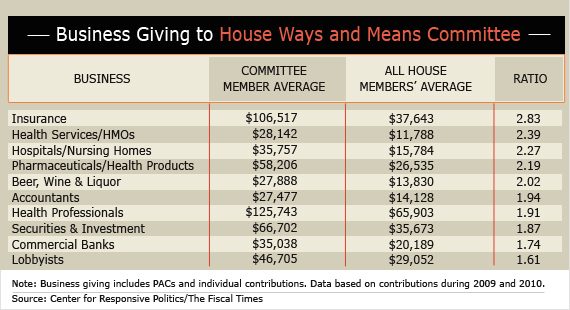It’s no secret that corporations and special interest groups that dominate lobbying in the nation’s capital routinely shower campaign cash on congressional committees directly affecting affect their business interests. But a study by the Center for Responsive Politics and The Fiscal Times found that special interests routinely target members of Congress who can do them the most good.
Members of many influential committees receive a disproportionate share of their campaign contributions from people and corporate political action committees with business before them, the study found. In some cases, members of key committees receive five or 10 times as much in campaign contributions from political action committees and individuals with business before their committees than the average member of Congress.

"Why waste money on members who have no influence when it matters on your key legislative concerns?" said Larry Sabato, director of the Center for Politics at the University of Virginia. "Congress is decentralized and only certain members affect specialized issues that concern many interest groups. That’s why groups concentrate on the committees that may regulate them or control their issue area."
This calibrated targeting by special interest groups coincides with a surge in PAC spending. During the 2010 election cycle, when the GOP won back control of the House, business PACs alone donated about $333 million to federal candidates and committees. That's up 3 percent from the 2008 election cycle, and up 18 percent from the 2006 election cycle, when Democrats wrested control of both chambers of Congress from Republicans.
Not everyone agrees this is an inherent problem in politics. A campaign contribution "doesn't mean they are buying something" and a contribution "doesn't guarantee that you'll have success" with issues before a committee, said Paul Miller, a lobbyist at Miller/Wenhold Capitol Strategies and a former president of the American League of Lobbyists.
Ideology and party affiliation can also drive campaign contributions, Miller said, not just the committees on which members of Congress sit. Money can flow to politicians, Miller added, because they "are supportive of your issues."
"I'm not going to be naïve and say there's not pay-to-play in this town, but I don't think it's as rampant or widespread as people think it is," Miller said.
One of the biggest magnets for special interest money is the powerful House Ways and Means Committee, which is responsible for writing tax legislation and bills affecting Social Security, Medicare and other entitlement programs.
The insurance industry is so keenly affected by the work of the committee that it donated nearly three times as much money during the past two years to the average member of this committee than to the average member of the House, according to the new Center for Responsive Politics/Fiscal Times analysis. The average current member of the committee received $106,500 from the insurance industry during the past two years. The average member of the House, meanwhile, collected $37,600 from these interests.
During the 2010 election cycle, Ways and Means members also received on average more than twice as much money as typical House members from the people and political action committees associated with hospitals and nursing homes, the pharmaceutical industry and interests affiliated with the health services industry and HMOs, the study indicates.
Sabato said that special interest groups donate money to legislators to reward them for sponsoring or voting in favor of bills they support. Or, they do it to curry favor with those who might be persuadable in the future, he said. "Anyone who believes otherwise is hopelessly naïve," Sabato added.
Craig Holman, a lobbyist for the consumer rights organization Public Citizen, agreed, saying that “money follows power.” According to Holman, "A well-devised influence-peddling strategy by a special interest group fairly consistently targets congressional leadership first, chairmen of committees of jurisdiction, members of committees of jurisdiction and finally the rest of congressional incumbents.”
Among notable examples:
THE HOUSE ARMED SERVICES COMMITTEE
People and PACs associated with the defense aerospace industry, which include companies such as Boeing and Lockheed Martin, gave the average member of the House Armed Services Committee about twice as much as the average member of the House during the 2010 election cycle. The same is true for the defense electronics industry, which includes companies such as Raytheon, General Dynamics and L-3 Communications, the makers of the whole-body scanners used in many U.S. airports.
Missouri Democrat Ike Skelton, who presided over the committee until he was defeated last November, was the No. 1 beneficiary among all federal candidates of the defense aerospace and defense electronic industries during the 2010 election cycle. Skelton's $132,900 in receipts from the people and PACs associated with the defense electronics industry is nearly 12 times the amount collected by the average current member of House between 2009 and 2010. Skelton’s $161,850 in contributions from the defense aerospace industry is nearly 11 times the House average. Overall, the defense sector was the most generous financial backer of Skelton's campaign, giving him more than $433,300 during the 2010 election cycle.
Rep. Howard "Buck" McKeon, R-Calif., who landed the House Armed Services Committee chairmanship after November's Republican electoral wave, collected $327,900 from defense sector interests during the 2010 election cycle, with 63 percent of that sum coming from PACs. McKeon received $158,900 from the defense aerospace industry alone, ranking him the No. 2 congressional beneficiary of money from these interests, behind Skelton, during the past two years.
Rep. Adam Smith, D-Wash., who now serves as the ranking member of the Armed Services Committee, collected $98,250 from defense sector interests during the 2010 election cycle. About 96 percent of that sum came from PACs. Defense aerospace interests, in particular, contributed $55,000 to Smith over that time frame, ranking them as his No. 3 industry backer.
THE SENATE FINANCE COMMITTEE
Between 2005 and 2010, members of the tax-writing Senate Finance Committee received an average of 75 percent more from people and PACs associated with the health services industry and HMOs, compared to the average member of the Senate. They also received more than 50 percent more money, on average, from the pharmaceutical industry and people and PACs affiliated with hospitals and nursing homes compared to the average member of the Senate.
Senators serve six-year terms, unlike members of the House, who serve only two-year terms. This means House members face a constant pressure to raise campaign funds, while the political money machines of senators experience more ebb and flow. Because of this volatility over two-year periods, analyses of senators' campaign finances are based on six years worth of data.
Senate Finance Committee Chairman Max Baucus, D-Mont., an architect of the massive health insurance reform law enacted last year, collected more than $1.9 million from health sector interests between 2005 and 2010. About 63 percent of this sum came from PACs. Health professionals and pharmaceutical industry interests each gave Baucus more than $500,000 during this time. Those amounts represented about twice as much as the average senator collected from health professionals and more than four times as much money from pharmaceutical interests compared to the average senator. During this period, the finance, insurance and real estate sector also gave Baucus more than $2.7 million.
Sen. Chuck Grassley, R-Iowa, the ranking member of the Finance Committee, meanwhile, raised about $1.1 million from both the health sector and the finance, insurance and real estate sector, during the same period. Health professionals, who gave Grassley $396,475 between 2005 and 2010, ranked as his No. 1 industry backer.
THE HOUSE ENERGY AND COMMERCE COMMITTEE
The telecom services and equipment industry, which includes companies such as Qwest Communications, gave 138 percent more money to the average member of the House Energy and Commerce Committee compared to the average member of the U.S. House during the 2010 election cycle.
The pharmaceutical industry, similarly, donated an average of 125 percent more to these committee members. The electric utilities industry contributed an average of 117 percent more.
Big players in the pharmaceutical industry include drugmakers such as Pfizer, Amgen and Merck, as well as the Pharmaceutical Research and Manufacturers of America (PhRMA). Exelon Corp., Southern Co., Dominion Resources and Duke Energy rank among the most prolific givers within the electric utilities industry.
And during the 2010 election cycle, the telephone utilities and oil and gas industries each donated about twice as much to the average member of the Energy and Commerce Committee compared to the average member of the House. AT&T and Verizon are among the biggest spenders among all telephone utilities company, while Koch Industries and ExxonMobil lead the way among the oil and gas industry.
Electric utilities ranked as the No. 1 financial backer of the campaign of Rep. Fred Upton, R-Mich., now the chairman of the House Energy and Commerce Committee, during the 2010 election cycle. Electric utilities interests contributed $190,600 to Upton, with more than 87 percent of this amount coming from PACs. This sum is also more than nine times the amount collected by the average House member during the past two years.
Upton was also the No. 1 beneficiary among House members of money from the waste management industry during the 2010 election cycle. These interests gave him $39,800 — more than 12 times the House average.
During the 2010 election cycle, Rep. Henry Waxman, D-Calif., who serves as the ranking member of the House Energy and Commerce Committee, was the No. 3 beneficiary among House members of money from the telecom services industry. People and PACs associated with telecom interests gave Waxman $57,500 during the past two years. That's more than eight times the amount of money collected from such interests by the average member of the House.
THE HOUSE AGRICULTURAL COMMITTEE
The average member of the House Agriculture Committee received about 155 percent more than the average member of the House during the past two years from the crop production industry, which includes companies such as American Crystal Sugar, National Corn Growers Association and Cargill, Inc. Agriculture Committee members also received an average of 144 percent more than the average member of the House from the agricultural services industry, which includes companies such as Archer Daniels Midland and Monsanto. Similar trends were observed among members of the Senate Agriculture Committee (see chart).
During the 2010 election cycle, the top two financial backers of the campaign of Rep. Frank Lucas, R-Okla., who is now the committee's chairman, were the crop production and agricultural services industries — which contributed $152,300 and $107,750, respectively, to him. That's eight times and 10 times as much as the average member of the House. Among House members, Lucas was also the No. 1 beneficiary of money from the poultry and eggs industry, collecting $25,000 — more than five times as much as the average member of the House.
The agricultural services and crop production industries were also the top two financial backers of the campaign of Rep. Colin Peterson, D-Minn., who is now the ranking member of the House Agricultural Committee. These interests contributed about $163,050 and $161,650, respectively, to Peterson's war chest — that's 15 times as much as the average member of the House from agricultural services interests and nine times as much as the average House member from crop production interests. Peterson was the No. 1 beneficiary, among House members, of money from the agricultural services industry. He was also the No. 2 beneficiary of money from poultry and eggs interests, behind Lucas, collecting $24,500.


Related Links:
Financial PACs Invest in Influential Freshmen (The Fiscal Times)
The Influence Game: NFL PAC Gave Nearly $600,000 (U.S. News)

